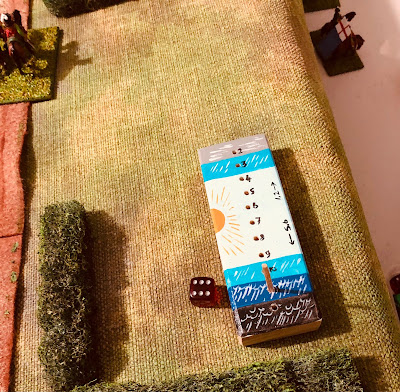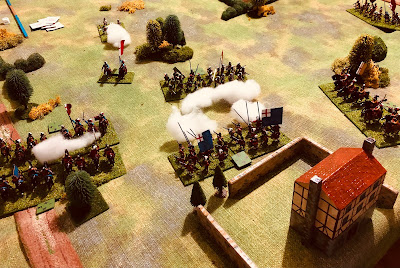I have been tinkering with the D3 English Civil War rules for a few weeks now. Originally, they were a variant of One Hour Wargames using D3 dice, but I have made further modifications to the artillery rules and turn sequence. The turn sequence was the largest change and uses homemade cards which determine the order in which a player’s units perform their actions. There are 10 cards in all:
5 Red cards
- Horse Activation
- Foot Activation
- Dragoon Activation
- Artillery Activation
- Commander Activation
5 Blue cards
- Horse Activation
- Foot Activation
- Dragoon Activation
- Artillery Activation
- Commander Activation
The deck is shuffled together into one card deck at the start of a turn. One player is assigned blue cards and the other red cards. As the cards are revealed, one at a time, a player activates the unit types on the card. Once complete, take the next card from the top of the pack and repeated until all cards have been drawn. Then shuffle the card deck for the start the next turn.
This mechanism is trying to reflect the difficulty of commanders coordinating the various parts of an ECW army. Players don't know the order that their unit types (infantry, cavalry, or dragoons) will be activated, or of their opponents. The updated rules can be found above or click here.
For the game I used the Battle of Hopton Heath description from the book "With Pike and Musket" by C.F. Wesencraft as inspiration. The Battle was fought 19 March 1643 between Parliamentarian forces led by Sir John Gell and Sir William Brereton who attempted to combined their forces to face a Royalist army under the command of the 2nd Earl of Northampton.
I decided to draw up a map to help show the positions and tabletop layout. It has been a long while since I drew one of these diagrams for a game. I do enjoy drawing them, but they do add time to creating a blog post.
 |
| Map of the Royalist deployment and Parliamentarian off table units. |
The game uses the weather barometer as described in the "With Pike and Musket" book. I made one a couple of weeks ago (see here). I have no idea as to what the weather was like on the actual day, but on my tabletop the day was looking pretty dismal with the possible threat of rain to come. A roll of 9 on 2D6 determined the weather which is adjusted by a D6 roll at the end of each turn, a 1 or 2 moves the peg up one slot on the barometer and a 5 or 6 move the peg down one slot.
 |
| Weather barometer |
The Royalists begin the game deployed between the two roads. Parliament forces arrive one unit each turn along one of the roads. The units arrive in the order of cavalry units first, then infantry units, and finally artillery units.
 |
| Initial deployment of the Royalist forces. Two Parliamentarian forces will arrive one unit each turn on the roads. (As a quick note I am using two bases for each unit in this game, artillery are still on a single base.) |
The game report in pictures...
















Peter, it is terrific to see your hand-drawn maps making an appearance again. I love them!
ReplyDeleteI like the notion of an activation deck. Typically, I have a card or chit for each command but have not tried allocating by troop type. THat is an interesting twist that allows the player to choose which unit to activate. I may give your method a try.
Good to see Wesencraft getting a work-out so early. One of my favorites.
The maps are fun, I had forgotten how much doing them helps one reflect on the game. The activation approach makes the army feel clunky to use rather than making individual units unpredictable.
DeleteGood to see the map again Peter and a nice looking game too. I'd forgotten about the weather stick, but can see it being very useful across a wide variety of periods and rules. Something to ponder for sure and to make one as and when time allows:)
ReplyDeleteThe weather stick (barometer) certainly had an influence and made for an interesting game.
DeleteParliament really got the rough, or should that be wet/muddy, end of the stick on this one. Nice to see the weather gausge in action - I must make one, and some rules for bad weather.
ReplyDeleteParliament were always on the back foot having a split force, but they certainly got no favours from the weather which only complicated matters fro them.
DeleteI like a random activation, it makes for a more interactive and dynamic game. Some systems allow everything to move in a turn, whatever order, but some others can have some units not activate, which is OK occasionally, but feels wrong when it happens turn after turn.
ReplyDeleteI know in ancients games, some complain about the likes of sword and Spear in which the whole line does not advance as one at the same time because of individual unit activation. If only we could time travel and see just how well a line holds up to synchronised manoeuvre! :0)
I tend to like a level of random activation in my game too, partly because I am a solo wargamer. With this approach I was trying to make the army feel clunky and uncoordinated and not Individual units, which always get to activate, but not necessarily in the order the player wants.
DeleteInteresting to see how the gradual worsening of the weather had such a marked impact on the game.
ReplyDeleteIt did make for an interesting game. I have played a few games now using the weather barometer and rules, and this was the first time the weather had become stormy.
DeleteI’d forgotten about the Weather Gauge. Tempted to make one now seeing it in action.
ReplyDeleteIt certainly added a twist to the game. In future games I may allow forces to delay my mutual agreement if the weather is problematic, and re-roll the dice accepting the second score for the weather (be it better or worse).
DeleteJust catching up... coming from a background of rules sets that chop the sequence of play up into cards in a somewhat more radical fashion (Piquet, Field of Battle, Die Fighting), I really like this idea!
ReplyDeleteThanks. I find it a nice system for creating uncertainty for moves in particular. Especially so with written orders.
DeleteTop looking game Peter. The weather was the 'star' of this one wasn't it?! I really like the idea of the barometer and your implementation of it looks great.
ReplyDeleteUsing cards by troop type is very much like the original Piquet (as Peter has already said) and is a great way of managing time/impetus, I reckon.
Regards, James
The weather certainly turned and made for an interesting game. The random order of activation of unit types seems to lend itself to this period.
DeleteAm I right in thinking that Parliament had two each of Horse, Foot and Artillery?
ReplyDeleteThat is correct, a total of 6 units (2xCavalry, 2xInfantry, 2xArtillery).
Delete